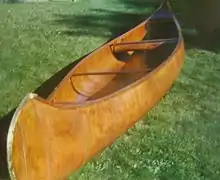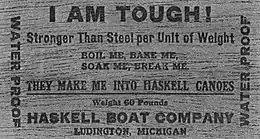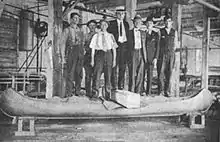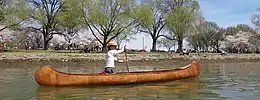Haskell canoe
The Haskell canoe was a boat built by the Haskell Boat Company in Ludington, Michigan. It was made with a single sheet of three-ply lightweight waterproof plywood. It was marketed throughout the United States and Canada. Peak production of the canoe occurred during the 1920s. The length was extended in 1930 and by 1934 it was no longer made.

Background
Henry L. Haskell was a businessman and inventor. He invented a waterproof glue that was used in the construction of a plywood referred to as haskelite. One of his products he manufactured with the plywood was military airplane body parts.[1] The glue was made from blood-albumin and used blood from the Chicago stock yard slaughterhouses.[2] Haskell made his business cards from pieces of the waterproof plywood which read,

from various haskelite plywood pieces
I AM TOUGH!
Stronger Than Steel per Unit of Weight
BOIL ME, BAKE ME,
SOAK ME, BREAK ME
THEY MAKE ME INTO HASKELL CANOES
Weight 60 pounds
HASKELL BOAT COMPANY
Construction

Haskell used this waterproof feature of the glue he invented to his benefit. He made a canoe from the plywood he manufactured with the glue. The canoe was made with a single sheet of three-ply lightweight plywood. The panel was about 5 feet (1.5 m) wide and 20 feet (6.1 m) long and molded into the shape of a canoe using hydraulic presses. The completed canoe, 16 ft (4.9 m) long, 32 in (81 cm) by beam and 12 in (30 cm) in depth, weighed 55 lb (25 kg), which was 20 lb (9 kg) lighter than the average canvas-covered canoe of the same dimensions.[4]
The glue Haskell invented[5] was with co-developer H.F. John and made from dried cow's blood.[6] It was subjected to various tests to ensure it would be adequate for constructing canoes, as the boats would be in water for hours at a time.[7] It was soaked in water for a lengthy time, boiled at high temperatures, and submerged in printer's ink. After getting good results from these experiments and tests, then the glue was employed in the making of the plywood used in the construction of the boats.[8]
The Haskell canoe was made from a sheet of three-ply haskelite plywood, 3⁄16 inch (4.8 mm) of an inch thick. The panel sheet was first softened by boiling for three hours and then pressed into a canoe form by a molding machine.[7] The slotted ends at the bow and stern were fastened together with a bent strip of ash. A hot steam process was used to form the inside belly double curvature of the bottom part of the canoe. Once the canoe dried it held that shape. The final process of construction was to attach the gunwales to the sides and seats to permanently form the canoe to a hull of one solid component.[1]

These canoes were first made in 1916 and put on the market for sale in 1917.[7] The name of the manufacturer was the Haskell Boat Company, which was an organization managed by the Haskell Manufacturing Company. It was based at 801 N. Rowe Street in Ludington, Michigan. The peak production time for the manufacturing of the canoes was in the 1920s. In 1930 the length was extended to a 17 foot (5.2 m) long canoe instead of the original 16 foot (4.9 m) boat.[7]

Marketing
The Haskell canoe was marketed and sold throughout the United States and Canada. One testimonial of 1930 from a tour guide of Kodiak Island in Alaska said that he used this canoe with much success in hunting bears.[9] The canoe was sold under the brand name Arex. The name means "King of the water."[10]
References
- Motor Boat 1920, p. 38.
- "Haskell Canoe". Online Library. Mason County Historical Society. 2016. Retrieved May 5, 2016.
The plywood and glue was made from albumin blood from Chicago stock yards.
- "Haskell Boat Company". Wooden Canoe Heritage Association. 2020. Retrieved October 8, 2020.
- Hardwood Record 1920, p. 36.
- Official Gazette 1922, p. 1082.
- Veneers and Plywood 1930, p. 18.
- Veneers and Plywood 1930, p. 19.
- Hardwood Record 1917, p. 37.
- "Haskell Canoe / Boats from Local Factory Used by Bear Hunters; Said to be Safest". Ludington Daily News. Ludington, Michigan. June 30, 1930. p. 3. Retrieved August 6, 2016 – via Newspapers.com
 .
. - "Haskell Finances Company to Manufacture Canoes and Boats in Tubbs Building". Ludington Daily News. Ludington, Michigan. October 19, 1916. p. 1.
Sources
- "Haskelite, a plywood for Boat Construction". Motor Boat. Volume 17. Motor Boat Publishing Company. 1920.
- Hardwood Record (1917). Hardwood Record. Volume 42. Hardwood Company.
- Hardwood Record (1920). Hardwood Record. Volume 49. Hardwood Company.
- Official Gazette (1922). Official Gazette of the United States Patent Office. The Office.
- Veneers and Plywood (1930). Veneers and Plywood. S.H. Smith.
Further reading
- "Some of the Boat Exhibits That Helped to Make the Show the Greatest Ever Held". Boats. Motor Boat publications. 1922. p. 17.
External links
| Wikimedia Commons has media related to Haskell canoe. |